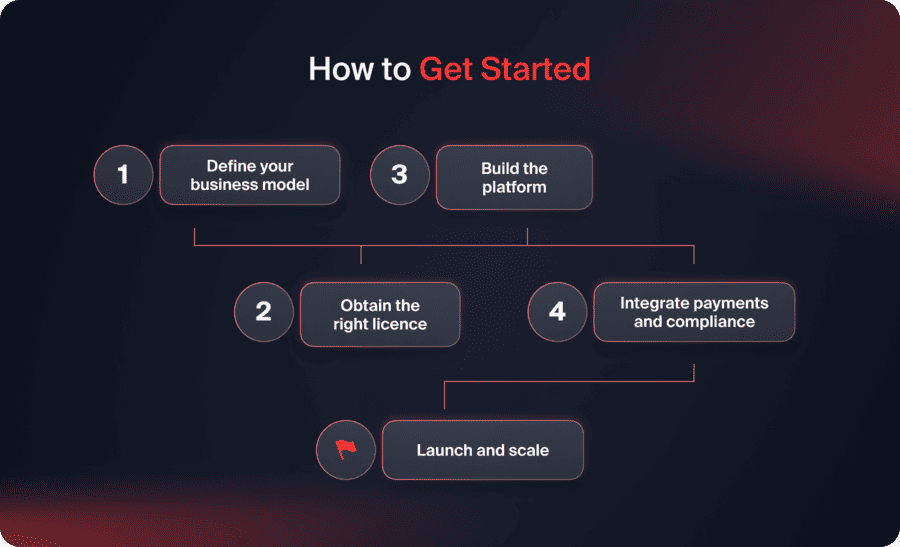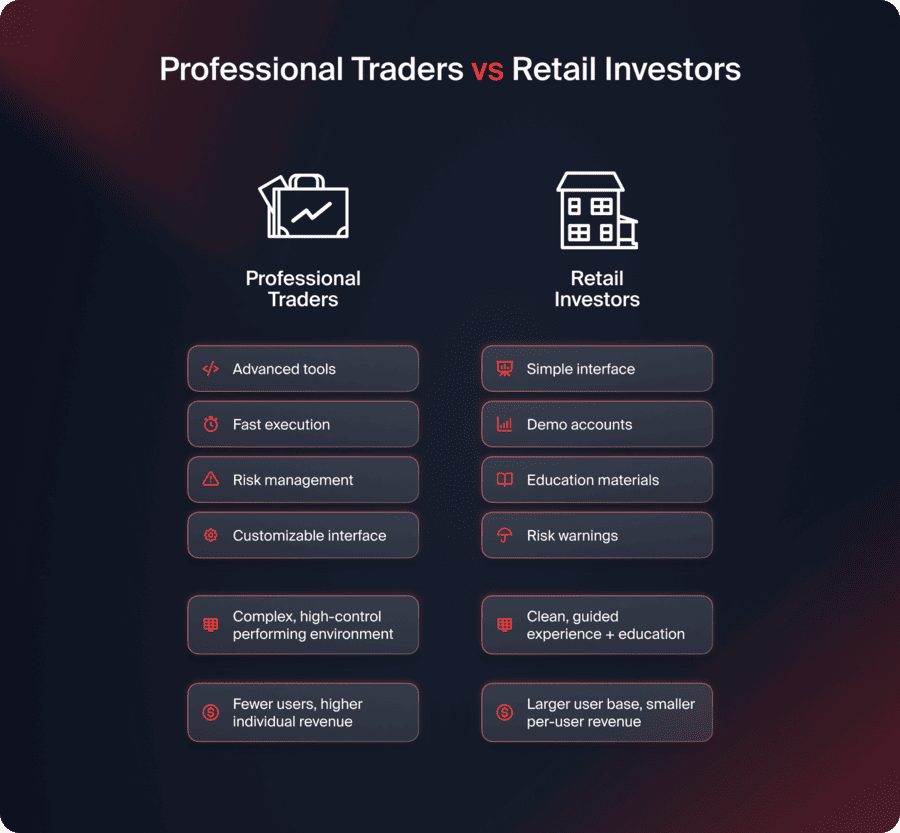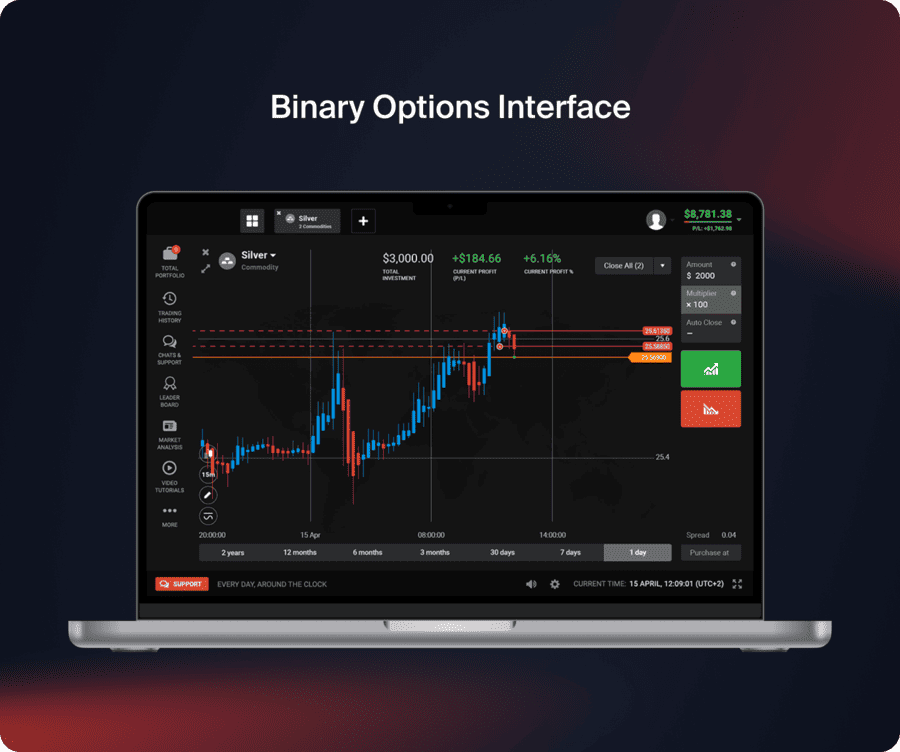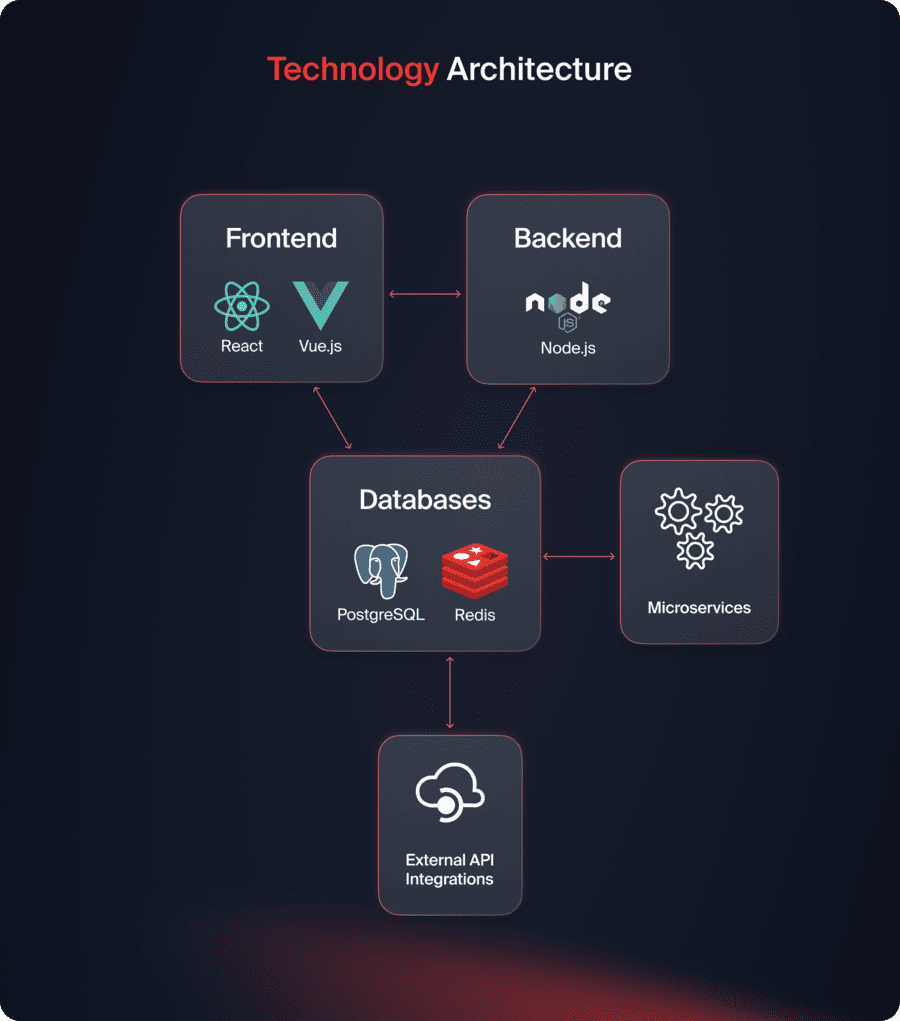
How to Launch Your Binary Options Trading Platform in 2026
Conteúdo
Launching a binary options trading platform in 2026 positions you in a $2.8 billion value market as of 2023, with expected values reaching $6.5 billion by 2032 at a 9.5% CAGR.
If you’re wondering how to get started, here’s a short answer before we dive into the details:
- Define your business model – choose your target users, assets, and payout logic.
- Obtain the right licence – register in a regulated or offshore jurisdiction.
- Build the platform – develop from scratch or use a white-label trading platform.
- Integrate payments and compliance – set up KYC, AML, and secure transaction flows.
- Launch and scale – attract traders through education, partnerships, and affiliate programs.
Let us now look at what it will require to build a compliant, scalable, and competitive platform in 2026.

But, Is Binary Options Business Profitable in 2026?
The global binary options broker market was $0.87 billion in size in 2024 and is forecast to grow to $1.85 billion by 2033 at a CAGR of 9.1%. A different set of alternative forecasts places the market higher, with the global binary options broker market being $2.8 billion in size in 2023 and forecast to reach $6.5 billion by 2032 at a 9.5% CAGR.. The differences exist because of methodology differences, but both confirm tremendous growth opportunities.
Mobile trading platforms are experiencing hypergrowth, with 60% of binary options trades now being executed by smartphone or tablet. This mobile dominance requires platform development emphasizing responsive design, touch-optimized UI, and app-based experience over desktop-first strategies. Your technology stack needs to acknowledge this shift from initial architecture decisions through final deployment.
Where Is Binary Options Trading Growing?
The Asia Pacific market is likely to demonstrate the maximum growth rate, being bolstered by growing internet penetration and middle-class expansion. Asia Pacific is developing rapidly, with additional traders coming on board to capitalize on the growth of binary options trading in China, India, and Japan. There exists a strategic potential for platforms serving emerging markets in localized payment, language support, and region-specific assets.
Europe and North America remain solid markets in spite of stricter regulations. The EU banned retail customer binary options trading in 2018, while the US restricts activity to CFTC-regulated exchanges like Nadex. The regulatory barriers create compliance concerns but also reduce competition between properly licensed platforms.
How Much Does It Cost to Build a Binary Options Platform?
Cost Structure Overview
- Basic platforms with fundamental trading features, simple asset selection, standard contract types, and web-only access run $80,000-$120,000 and take 4-6 months to build.
- Medium complexity platforms with native mobile apps, advanced charts, multiple contract types, full back-office systems, and enhanced security cost $150,000-$250,000 and need 6-9 months.
- Advanced enterprise platforms with AI analytics, social trading, copy trading, sophisticated risk management, and multi-country compliance run $300,000-$600,000+ and require 12-18+ months of development.
- White label solutions get you live in 4-8 weeks for $30,000-$80,000 upfront plus ongoing licensing fees.
Recurring Operational Costs
Cloud hosting scales with your users: $3,000-$12,000 a month for servers, databases, and application infrastructure. Market data subscriptions add another $500-$5,000, depending on asset coverage. Payment processing takes 2-5% of every deposit and withdrawal. Compliance (legal counsel, regulatory reporting) runs $8,000-$20,000 monthly.
Your biggest expense? Customer acquisition and marketing: $15,000-$100,000+ per month, depending on where you're targeting. Since major platforms ban binary options ads, you'll need to lean heavily on affiliate programs, content marketing, and partnerships.
How Do Binary Options Platforms Make Money?
Binary options platforms earn money the majority of the time through the disparity between profitable and losing trades. When the traders make accurate price forecasts, they get rewarded with fixed sums, typically in the range of 70-95% of the initial investment. Losing trades forfeit the entire investment, and the broker gets to retain such funds minus successful trade payouts. The house-edge system must have payout percentages well-balanced against operating costs and trader retention.
What Are Additional Revenue Streams?
Complementary sources of revenue complement primary trading revenue. Tiered premium account tiers charge a monthly fee for higher payout rates, personal account managers, or better analytics. Educational content, signal services, and copy trading generate additional revenue while increasing the success rates of traders. Your brokerage business model should diversify the sources of income to buffer itself against changes in trading volumes.
Who Should You Target with Your Binary Options Platform?
Defining your target market puts you in a powerful position to make the most of your binary options trading platform. Professional traders are major stakeholders that you need to prepare to cater to. They need advanced tools, fast execution, risk management tools, and easy-to-use interfaces for maximum functionality.
Retail traders, particularly new ones, need clean interfaces guiding them in trade setup without being bogged down by too many choices. Educational materials, demo accounts, and risk warnings educate new entrants on binary options mechanics before risking real capital. Some jurisdictions mandate investor education certification and suitability screening before allowing live trading, so these aspects are regulatory must-haves.

Are Binary Options Legal? What Licenses Do You Need?
Binary options are better controlled than some financial products due to historical misuse of the sector. The sale, distribution, and promotion of binary options to retail consumers in the EU were banned by the European Securities and Markets Authority (ESMA) in 2018. The United States merely permits trading binary options on CFTC-regulated exchanges and derivatives, and Nadex is currently the sole operating platform.
Where Can You Get a License for Binary Options Trading?
Offshore locations provide low-cost licensing with less weight and faster processing. Seychelles Financial Services Authority, Vanuatu Financial Services Commission, and Labuan Financial Services Authority are the best options. They cost between $10,000 and $50,000 with a processing time of 2-4 months, which is perfect for new startups with little capital.
However, offshore licenses carry credibility problems and advertising prohibitions. Many payment processors refuse to join offshore-licensed binary options websites due to fraud concerns. Google, Facebook, and other major advertising venues will not permit advertising for binary options, which means you will have to rely on alternative marketing channels.
You can consider new regulated markets in Latin America, Africa, and Asia offering balanced regulatory frameworks without prohibitively high costs.
You may also like

What Compliance Requirements Do You Need?
Robust compliance regimes are your company's cornerstone, steering clear of regulatory violations, sparking fines, or license revocation. Know Your Customer (KYC) procedures verify trader identities with the use of government documents, address verification, and potentially selfie pictures, verifying that the applicant looks like their ID. Automated checking tools like Sumsub or Jumio facilitate this work while providing audit trails.
Anti-Money Laundering (AML) controls monitor transactions, logging suspicious activity like sudden deposits and withdrawals, unusual trading patterns, or associations with criminal activity. Controls like deposit limits, loss limits, self-exclusion, and cooling-off periods all work against binary options trading's gambling-like features. Most jurisdictions necessitate these controls for retail customers.
How to Build Your Binary Options Trading Platform?
To build your binary options trading platforms, there are some key factors you must take note of. Some of these have been highlighted below.
Features to Include
Binary options trading interfaces are different from regular stock or forex platforms. Traders need to: pick an asset, choose whether the price goes up or down, and enter their investment amount, and confirm the trade.
Your interface needs to clearly show potential payouts, expiration times, current prices, and recent price history. Everything should be obvious at a glance.
Trades need to execute in milliseconds and confirm instantly. Real-time charting with technical analysis tools (candlestick charts, line charts, area charts covering timeframes from 1-minute to daily) helps traders make informed decisions.

What Assets Should You Offer?
Start with the essentials: major currency pairs (GBP/USD, USD/JPY), popular stocks (Apple, Tesla, Amazon), commodities (gold, silver, oil), crypto pairs (BTC/USD, ETH/USD), and major indexes (S&P 500, NASDAQ, FTSE 100).
Many brokers are expanding into newer asset classes like more cryptocurrencies, ETFs, and even options based on economic indicators.
What Contract Types Should You Include?
Variety keeps traders engaged, so beyond simple "will it go up or down" predictions, try to offer:
- Touch/No Touch contracts – wins if the price hits (or doesn't hit) a specific level before expiry
- Range contracts – profits when prices stay within boundaries
- Ladder contracts – multiple strike prices with different payouts for structured risk/reward
What Risk Management Features Are Required?
Position size calculators help traders figure out appropriate investment amounts based on their account size and risk tolerance. Maximum single trades are limited to 5-10% of account value by most platforms to prevent account blow-ups.
Cooling-off periods impose breaks after consecutive losses or when daily loss limits are reached, allowing traders to step back and reconsider their strategy.
Negative balance protection stops traders from losing more than their account balance, even when markets behave extremely erratically. Clear disclosure of maximum losses per trade and potential outcomes isn't just best practice—regulators typically require it.
You may also like

What Technology Do You Need for a Binary Options Platform?
Frontend and Backend Development
React or Vue.js work great for building responsive interfaces that work smoothly across desktop, tablet, and mobile browsers. Progressive Web Apps (PWAs) give you app-like functionality without dealing with Apple and Google's app store approval process and restrictions.
Node.js is best suited for live streams of information and dealing with multiple connections required in trading platforms. PostgreSQL stores user accounts, transaction history, and trade data with solid reliability. Redis provides lightning-fast caching for real-time prices and live positions.
Microservices architecture contains the trading engine, user management, payments processing, and reporting within distinct services, each scaling independently based on demand. These architectural components are often pre-integrated with white label trading platforms, reducing the level of development complexity.
How Do You Get Real-Time Market Data?
Real-time price feeds from providers like IEX Cloud, Alpha Vantage, or CryptoCompare power your platform's market data. Binary options need second-by-second price accuracy since trades are decided at exact expiration times.
For crypto, you'll need connections to multiple exchanges and should average prices to prevent manipulation from sudden spikes on individual exchanges. Whatever your approach, regulators expect clear disclosure of your price sources and calculation methods.

From our experience, we’ve discovered that payment processing, banking relationships, and operational infrastructure require as much attention as trading technology. Our solutions include pre-integrated payment processors, compliance systems, and proven operational workflows that prevent these oversight failures.
Conclusion
The successful launch of a binary options platform in 2026 involves the successful navigation of sophisticated regulation, utilization of grade-A risk management, and cutting-edge technology or specialized know-how in the growing market. Leveraging established trading platform solutions also shortens time-to-market.
Moreover, it aligns resources for regulatory compliance and customer acquisition strategies that avoid advertising prohibitions. Strategic placement in emerging markets, cryptocurrency support, and education leadership create enduring competitive strengths in this challenging but profitable fintech sector.
FAQ
Basic platforms cost $80,000-$120,000, and advanced systems $300,000-$600,000+. White label platforms cost $30,000-$80,000 for the base license and optional additional license fees. Compliances, marketing, and infrastructure fees are an extra $30,000-$150,000+ per month.
The EU banned outright retail binary options, and the US restricts operations to CFTC-regulated exchanges like Nadex. Offshore locations, like Seychelles, Vanuatu, and Labuan, offer low-cost licensing priced at $10,000-$50,000 with a 2-4 month processing time, but with marketing and banking limitations.
Platforms make profits on the difference between winning and losing trades. Losing trades lose their entire investments, while winning trades earn 70-95% returns, and brokers retain the spread. When not considered, other profits are made from premium memberships, trading signals sales, and the selling of educational materials.
White label offerings come to market in 4-8 weeks, with customization and licensing. Custom development takes 4-6 months for simple platforms, 6-9 months for medium-complexity, and 12- 18+ months for complex systems. Regulator licensing takes an additional 2-6 months, depending on location.
The legality of binary options varies significantly by jurisdiction. They're banned for retail users in the EU, restricted to CFTC exchanges in America, but permitted in most of Asia, Africa, and Latin America with appropriate licensure. Always review regulatory status in target markets before release.
Atualizado:
26 de novembro de 2025




